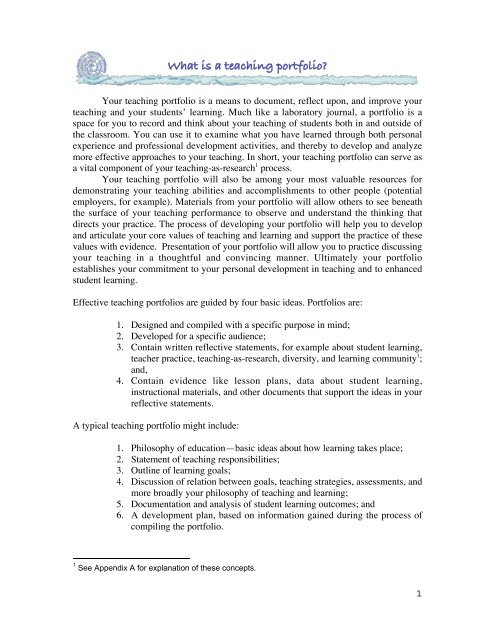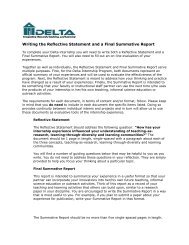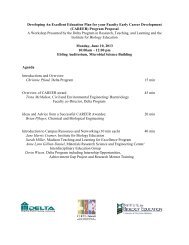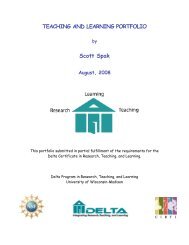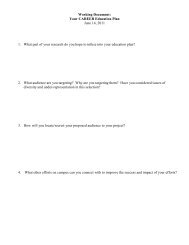TEACHING AND LEARNING PORTFOLIOS ... - Delta Program
TEACHING AND LEARNING PORTFOLIOS ... - Delta Program
TEACHING AND LEARNING PORTFOLIOS ... - Delta Program
Create successful ePaper yourself
Turn your PDF publications into a flip-book with our unique Google optimized e-Paper software.
What is a teaching portfolio?<br />
Your teaching portfolio is a means to document, reflect upon, and improve your<br />
teaching and your students’ learning. Much like a laboratory journal, a portfolio is a<br />
space for you to record and think about your teaching of students both in and outside of<br />
the classroom. You can use it to examine what you have learned through both personal<br />
experience and professional development activities, and thereby to develop and analyze<br />
more effective approaches to your teaching. In short, your teaching portfolio can serve as<br />
a vital component of your teaching-as-research 1 process.<br />
Your teaching portfolio will also be among your most valuable resources for<br />
demonstrating your teaching abilities and accomplishments to other people (potential<br />
employers, for example). Materials from your portfolio will allow others to see beneath<br />
the surface of your teaching performance to observe and understand the thinking that<br />
directs your practice. The process of developing your portfolio will help you to develop<br />
and articulate your core values of teaching and learning and support the practice of these<br />
values with evidence. Presentation of your portfolio will allow you to practice discussing<br />
your teaching in a thoughtful and convincing manner. Ultimately your portfolio<br />
establishes your commitment to your personal development in teaching and to enhanced<br />
student learning.<br />
Effective teaching portfolios are guided by four basic ideas. Portfolios are:<br />
1. Designed and compiled with a specific purpose in mind;<br />
2. Developed for a specific audience;<br />
3. Contain written reflective statements, for example about student learning,<br />
teacher practice, teaching-as-research, diversity, and learning community 1 ;<br />
and,<br />
4. Contain evidence like lesson plans, data about student learning,<br />
instructional materials, and other documents that support the ideas in your<br />
reflective statements.<br />
A typical teaching portfolio might include:<br />
1. Philosophy of education—basic ideas about how learning takes place;<br />
2. Statement of teaching responsibilities;<br />
3. Outline of learning goals;<br />
4. Discussion of relation between goals, teaching strategies, assessments, and<br />
more broadly your philosophy of teaching and learning;<br />
5. Documentation and analysis of student learning outcomes; and<br />
6. A development plan, based on information gained during the process of<br />
compiling the portfolio.<br />
1 See Appendix A for explanation of these concepts.<br />
1


